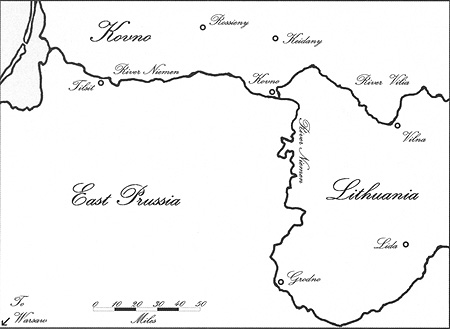Napoleon’s Eagles:
Russia 1812
A Clash of Giants
by Kevin Birkett, FINS, Eire
| |
Relations between the protagonists had been deteriorating for some time for a multitude of reasons but principally over the Tsar’s non-compliance with obligations that he had entered into, at Tilsit in 1807, to join Napoleon’s ‘Continental System’. The Russians meanwhile were very suspicious of Napoleon’s attempts to re-establish the Polish nation and of French influence in Constantinople. From the beginning of 1811 both leaders began to make preparations for what they both believed to be the inevitable conflict. In February and March 1812 Napoleon concluded treaties with Prussia and Austria respectively to supply troops for his army. However a month later the Tsar hit back on the diplomatic front when he signed treaties with Sweden and Turkey. The Peace of Bucharest with Turkey, signed on the 12th May, was particularly important as it released vast numbers of Russian troops to serve in the upcoming campaign. Throughout the spring and early summer an unending river of men and equipment flowed eastwards towards the Russian frontier. By the eve of the invasion the Emperor had amassed some 675,000 men supported by 1393 guns with which to force the Tsar to rejoin his embargo on trade with the British. Facing these legions the Tsar had, initially, around 218,000 men massed into three main armies. The largest of these, consisting of some 127,000 men and 584 guns, was the Minister of War General Barclay de Tolly’s First Army of the West. This imposing array was strung out in a 150-mile cordon along the frontier from Rossieny through Kovno to Lida in Lithuania. General Wittgenstein’s First Corps was deployed around Rossieny. Further south, around the town of Kovno, were Baggavout’s Second, Tutchkov’s Third and Ostermann-Tolstoi’s Fourth Corps screened by Hetman Platov’s Cossacks; while to their left Doctorov’s Sixth and Pahlen’s Third Cavalry Corps stood sentinel around Lida. Some 75 miles to the rear of these formations was Barclay’s reserve consisting of Grand Duke Constantine’s Fifth, Uvarov’s First Cavalry and Korf’s Second Cavalry Corps. By the time hostilities commenced the Tsar’s second army, General Bagration’s 48,000 strong Second Army of the West, was already marching north to join its nominal commander. Nevertheless by the 23rd June Bagration’s army, consisting of Raevski’s Seventh, Borozdin’s Eighth and Sievers’ Fourth Cavalry Corps, had only reached the vicinity of Volkovysk. Lastly the Tsar’s third army, General Tormassov’s 43,000 strong Third Army of the West, was still forming in early June and would not be of any immediate assistance. In the fullness of time two further armies would become available for use against the French invaders, Admiral Tshitsagov’s Army of the Danube and General Steinheil’s Army of Finland. The Emperor had divided his 675,000 men into, excluding the Imperial Guard, twelve infantry and four cavalry corps, the bulk of which were to remain under his direct control. Facing the centre of Barclay’s army Napoleon had the Imperial Guard, Davout’s I, Oudinot’s II, Ney’s III, Nansouty’s I Cavalry and Montbrun’s II Cavalry Corps, in all some 218,000 men and 500 guns. In support of these formations Prince Eugène commanded his own IV Corps together with St. Cyr’s VI and Grouchy’s III Cavalry Corps, totalling 80,000 men and 200 guns. Further back, and at the commencement of the campaign still forming, were Victor’s IX and Augereau’s XI Corps. These would eventually muster approximately 83,000 men and 140 guns. Napoleon’s plan was simple. Using the corps under his direct command, he would cross the River Niemen at Kovno, splitting the First Army of the West in two. Then, pivoting around Vilna, this force would swing south enveloping the southern half of Barclay’s army and, provided his brother fulfilled his task, Bagration’s Second Army of the West. A vital component of this plan was the Emperor’s brother King Jérôme of Westphalia who, advancing from Warsaw, had own VIII, Poniatowski’s V and Latour-Maubourg’s IV Cavalry Corps, totalling 62,000 men and 128 guns, with which to draw Bagration’s army deeper into the Emperor’s trap. North and south of this massive snare three further corps, Macdonald’s X, Reynier’s VII and Prince Schwarzenberg’s Austrian Hilfkorps, stood guard over the flanks of the Grande Armée. The Tsar’s plan was also very simple, to retreat in the face of this onslaught, sacrificing land to buy time to utilise the vast resources of his empire. In the event the Tsar’s plan was to prove the more successful. Napoleon's Eagles (Part 1) Invasion of Russia 1812
From the Niemen to the Dvina Battle of Saltanovka Maneuver of Vitebsk Battle of Ostronovo Maneuver of Smolensk Napoleon's Eagles (Part 2) Invasion of Russia 1812 by Kevin Birkett
Battle of Smolensk Sideshow: Oudinot's Dvina Campaign First Battle of Polotsk Volhynian Summer Jumbo Map of Battle of Smolensk (very slow: 278K) Napoleon's Eagles (Part 3) Invasion of Russia 1812
Battle of Borodino Interregnum and Retreat Battle of Vinkovo Jumbo Map of Battle of Borodino (extremely slow: 372K) Back to Table of Contents -- First Empire # 78 Back to First Empire List of Issues Back to MagWeb Master Magazine List © Copyright 2004 by First Empire. This article appears in MagWeb.com (Magazine Web) on the Internet World Wide Web. Other articles from military history and related magazines are available at http://www.magweb.com |
 At 10 p.m. on the evening of the 23rd
June elements of the I Corps of the Grande
Armée crossed the River Niemen in the vicinity
of Kovno. Napoleon’s long planned invasion
of Russia had begun.
At 10 p.m. on the evening of the 23rd
June elements of the I Corps of the Grande
Armée crossed the River Niemen in the vicinity
of Kovno. Napoleon’s long planned invasion
of Russia had begun.